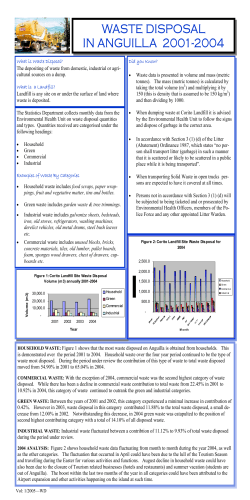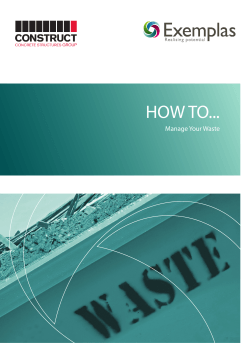
Construction and Demolition Waste in Nebraska An Overview of Managing Waste
Construction and Demolition Waste in Nebraska An Overview of Managing Waste Generated from Construction and Demolition Projects 1 What is Construction and Demolition Waste? It is important to know what construction and demolition waste is, how it can be properly handled and where it must be legally disposed. Before beginning a C&D project, contact your local city or county authorities. They may have more stringent requirements. Construction and Demolition (C&D) waste is defined and regulated by the Nebraska Department of Environmental Quality in Title 132 – Integrated solid Waste Management Regulations. C&D waste is defined as waste that results from land clearing; the demolition of buildings, roads, or other structures; or construction projects. C&D waste includes, but is not limited to: u u u u u u u u u u Fill materials Wood (including painted and treated wood Land clearing debris other than yard waste Wall coverings (including wallpapers, paneling, and tile) Drywall, plaster, and non-asbestos insulation Roofing shingles and other roof coverings Pipe and metals, plumbing fixtures Glass, plastic Carpeting Electrical wiring “Fill” shall mean solid waste that consists only of one or more of the following: sand, gravel, stone, soil, rock, brick, concrete rubble, asphalt rubble, or similar material. Specific types of fill can be used for the purpose of erosion control, erosion repair, bank stabilization, landscaping, roadbed preparation, and other land improvement. C&D waste shall not include friable asbestos waste, special waste, liquid waste, putrescible waste, household waste, industrial solid waste, corrugated cardboard, appliances, tires, drums, fuel tanks, hazardous waste, and waste that contains polychlorinated biphenyl (PCB). These products require specific attention for their disposal. C&D waste MUST be disposed of in a permitted C&D landfill or a municipal solid waste landfill. Improper disposal of C&D wastes can lead to enforcement actions being taken by the NDEQ and might include penalties in addition to requiring proper cleanup and disposal. NDEQ recommends that building materials be recycled or reused, provided that solid wastes are not mixed in the material to be used or recycled. 2 C&D Dos and Don’ts The following options for C&D waste disposal ARE allowed: u Separate brick and concrete from demolition waste. Use the brick and concrete for land improvement and stabilization projects. Haul remaining waste to a permitted landfill. (Corps of Engineers does not allow brick to be used in fill projects in waters of the state.) u In the case of a natural disaster, obtain permission from the NDEQ to open a temporary disposal area. u Bury farm buildings such as bins, sheds, and barns on the farm property where they were standing. (Structure only, no contents.) The following methods for C&D disposal ARE NOT allowed: u Demolishing a building or house and burying it on site (dropping it into the basement). However, C&D materials that meet the definition of fill may be utilized to fill the basement as a means of land improvement or landscaping. u Demolishing a building or house and hauling it to a farm to bury it. u Using demolition waste other than soil, rock, brick, concrete rubble, and asphalt rubble as fill for land improvements. (Corps of Engineers does not allow brick or asphalt to be used in fill projects in waters of the United States.) u Depositing demolition waste in a stream, creek, river or wetland. u Depositing fill in a stream, creek or river in such a way that it impacts the flow of the stream or the capacity of the flood plain without first obtaining a permit from the Corps of Engineers. u Disposing of the ash from a burned building in the same manner as any of the illegal methods stated above. u Open burning of buildings or demolition waste. Before burning any materials from demolition or construction activities, you should contact the NDEQ at (402) 471-2189, and then local fire officials to see if it is allowable. u Demolishing a commercial, industrial, institutional, or public building without a thorough inspection to identify asbestos-contaminated materials and properly notifying the NDEQ Air Quality division, (402) 471-2189 and/or the Nebraska Department of Health and Human Services at (402) 471-0386. If the demolition project is in Lincoln, NE or Omaha, NE you must contact their local programs directly. 3 Licensed C&D Facilities The following permitted C&D waste facilities are licensed with the State of Nebraska. Contact your local municipal solid waste landfill to determine if it also accepts C&D waste. Abe’s Trash Service, Inc. Anderson Excavating & Wrecking Co., Calhoun Road Bud’s Sanitary Service Butler County Landfill, Inc City of Alliance C&D Landfill City of Kimball City of Lincoln, North 48th Street City of O’Neill City of Plainview Gage County C&D Waste Disposal Facility Hawkins Construction Co. Lexington Area Solid Waste Agency (LASWA) Loup Central Landfill Assoc. NPPD Gerald Gentleman Station PAD LLC Porter Construction Schmader Sidney Area Solid Waste Agency Southwest Nebraska Solid Waste Agency Stewart Construction Village of Arnold Omaha (402) 571-4926 Omaha Newman Grove David City Alliance Kimball Lincoln O’Neill Plainview Beatrice Omaha (402) 345-8811 (402) 447-6472 (402) 367-4662 (402) 762-5400 (308) 235-3639 (402) 441-7867 (402) 336-3090 (402) 582-4928 (402) 223-4011 (402) 342-1607 Lexington Elba Sutherland Hastings Pierce West Point Sidney Imperial Indianola Arnold (308) 324-3351 (308) 863-2122 (308) 563-5355 (402) 463-4545 (402) 371-2900 (402) 372-3833 (308) 254-5300 (308) 882-4368 (308) 345-7070 (308) 848-2228 4 C&D - Did You Know? u In the United States, an estimated 136 million tons of building-related C&D waste was generated in 1996* (compared to 208 million tons of municipal solid waste in 1996). u An estimated 20 to 30 percent of building-related C&D waste was recovered for processing and recycling in 1996. The materials most frequently recovered and recycled were concrete, asphalt, metals and wood. u An estimated 35 to 45 percent of building-related C&D waste was sent to C&D landfills in 1996. An estimated 30 to 40 percent of C&D waste is disposed of at municipal solid waste landfills (or unpermitted disposal sites). An estimated 15 to 35 percent is disposed of illegally. u Building demolitions account for 48 percent of the waste stream, or 65 million tons per year; renovations account for 44 percent, or 60 million tons per year; and 8 percent, or 11 million tons per year, is generated at construction sites. u A 1994* survey by Franklin Associates identified about 1,900 active C&D landfills in the United States. C&D Recycling, a trade journal, estimates that about 3,500 operating facilities process C&D materials in the United States. * most recent data available 5 Special C&D Disposal Requirements Fill While fill can be used for erosion control, erosion repair, and bank stabilization, special considerations are required for its use in waters of the U.S. as regulated by the Corps of Engineers. Waters of the U.S. include rivers, lakes, streams, and wetlands. Any fill within these waters requires coordination with the Corps of Engineers to determine whether a permit is needed for the activity. In addition, the fill to be used in waters of the U.S. must meet the requirements for suitable materials as defined by the Corps of Engineers. Unsuitable materials include asphalt, brick, trash, debris, car bodies, and concrete with exposed rebar. Scrap Tires Scrap tires are not acceptable C&D waste. Title 132, Chapter 14 provides criteria for accumulating waste tires for reuse, recycling, or shipping to another state. A list of approved scrap tire haulers is available on the NDEQ website. Asbestos Friable asbestos is not acceptable C&D waste. Guidance on asbestos removal and disposal can be found in Title 178, Chapter 22. Title 178 is available on the Nebraska Department of Health and Human Services website (http:// dhhs.ne.gov/) or call (402) 471-0386. The Lincoln-Lancaster County Health Department is responsible for the National Emission Standards for Hazardous Air pollutants (NESHAPS) program in Lancaster County, and the Omaha Air Quality Control Agency is responsible for the NESHAPS program within the Omaha city limits. 6 Managing Solid Waste The following provides guidance to communities in their management of solid waste: Use of a Closed Landfill Site – The NDEQ allows closed landfill sites to be used for the collection of recyclable materials or for composting yard wastes, provided that materials are routinely removed for recycling. Tree and Brush Piles – The NDEQ issues 5-year permits to municipalities for the purpose of burning piles of tree limbs and brush for volume reduction. The burn permit allows only the burning of tree branches and untreated wood. Burning such things as leaves and grass clippings, creosote wood, treated lumber products, painted wood, or building demolition materials is prohibited. Yard Waste – Yard waste is defined as leaves and grass clippings. From April 1 to November 30, yard waste may not be disposed of in a landfill. Household Appliances (White Goods) – Household appliances are banned from landfills. The ban applies to clothes washers and dryers, water heaters, heat pumps, air conditioners, dehumidifiers, refrigerators, freezers, trash compactors, dishwashers, conventional ovens, ranges, stoves, and wood stoves. Appliances not listed here should be recycled, or can be taken to a permitted municipal solid waste landfill. Additional Landfill Bans – The following items are banned from landfills statewide. Contact your landfill or hauler for details. u u u u Waste Oil Lead acid batteries (car batteries) Waste Tires Unregulated hazardous waste (Household hazardous waste is allowed but local programs exist for its disposal, call (402) 471-4210). Illegal Dump Site Cleanup Program The Illegal Dumpsite Cleanup Program, established in 1997, provides funding assistance to political subdivisions for the cleanup of solid waste disposed of along public roadways or ditches. Through this program, items such as household waste, white goods, C&D waste, and furniture are removed from the illegal site and recycled or disposed of properly at a permitted facility. For a grant application, contact the NDEQ. Key Contacts Nebraska Department of Environmental Quality (NDEQ) 1200 “N” Street, Suite 400 PO Box 98922 Lincoln, Nebraska 68509 (402) 471-2186 or toll-free at (877) 253-2603 http://deq.ne.gov/ United States Army Corps of Engineers - Omaha District Wehrspann Field Office 8901 South 154th Street Omaha, NE 68138-3621 (402) 896-0896 www.nwo.usace.army.mil Kearney Field Office 1430 Central Avenue Kearney, NE 68847 (308) 234-1403 www.nwo.usace.army.mil Other Contacts Environmental Protection Agency - Region 7 US EPA Region 7 Office of External Programs 901 N. 5th Street Kansas City, KS 66101 (913) 551-7003 or Toll-free: (800) 223-0425 www.epa.gov/region7 Nebraska Association of Resource Districts 601 S. 12th Street, Suite 201 Lincoln, NE 68508 (402) 471-7670 www.nrdnet.org Produced by Nebraska Department of Environmental Quality, P.O. Box 98922, Lincoln, NE 68509-8922. To view this and other information related to our agency, visit our website at www.deq.state.ne.us. This material is intended for guidance purposes only. It is not meant to substitute for local, state or federal regulations. All programs and services of agencies in this brochure are available to all people.
© Copyright 2026





















